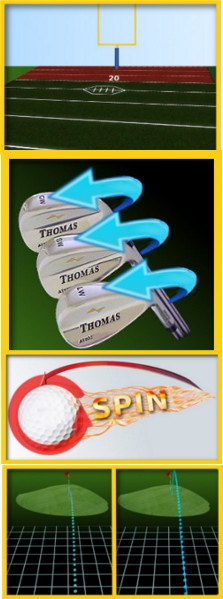
In football, a team expects to score at least a field goal when it reaches the “red zone,” the area inside the opponent's 20-yard line. Golf's red zone extends to 100 yards from the hole, but the concept is similar. When you reach this range, you must take advantage of the opportunity.
Professional golfers are, well, pros when it comes to getting up and down from 100 yards and in. They're able to control not only the distance of their shots, but the spin and trajectory as well.
You may never reach tour-level proficiency in the red zone, but you can knock several strokes from your average score by honing in on these keys:
- Carry at least three wedges: Most golfers carry a pitching wedge, which features 47° - 50° of loft, and a sand wedge with 56°. A lob wedge (60° - 64°) is a great weapon when you need to hit very high shots over hazards and stop the ball quickly on the green. Consider adding a gap wedge (51° - 53°), which will eliminate the need to hit tricky half- and three-quarter shots from yardages between your pitching and sand wedges.
- Use a ball with sufficient spin: Pros play golf balls with the highest spin rates, though these aren't necessarily the best choice for amateurs. If you want better control around the greens without losing much (if any) distance off the tee, look for balls with urethane covers and two- or three-piece construction. They'll fly plenty far, but tend to stop more quickly on the greens than surlyn or ionomer-covered balls.
- Learn different shots: You need to be versatile to score from close range. That means learning to hit the ball high when you need to land it on a small section of green, and low when the situation calls for a running shot. Ball position is the key to altering your trajectory. Follow these basic rules:
•To hit the ball high, play it nearer your left (lead) foot.
•To hit it low, play the ball in the center or just right of center in your stance.
A small change in ball position can make a notable difference in flight. Experiment on the range to get a feel for this nuance.
- Play smart: No matter how much you practice or play, you'll inevitably face challenges you can't conquer – and you shouldn't try to. Let say you've got a 50-yard shot to a flagstick cut just a few paces behind a deep bunker. To get it close, you'll have to hit a high, delicate shot that lands in the perfect spot. Miss short and you're in trouble. The smart play is to purposely hit the ball past the pin, or to aim away from the bunker. You probably won't get up and down, but you won't cost yourself strokes, either.
Few amateur golfers devote enough time or focus to the red zone, even though 60-80% of all shots (including putts) occur there. Dedicate yourself to improving in this area and you'll be way ahead of the game.
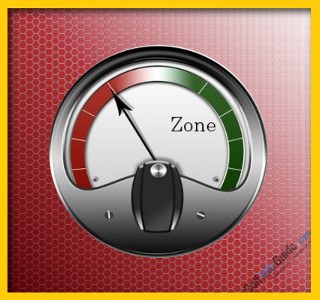
How to Score Inside Golf's Red Zone
If you are a football fan, you are already familiar with the term 'red zone'. In the football world, this term applies when the offensive team has the ball inside the 20-yard line. When a team is 20-yards or less from the end zone, they certainly hope to score – ideally a touchdown, but at least a field goal. Often, the game is decided by which team is better able to execute their game plan within the red zone. Scoring touchdowns instead of field goals can easily be the difference in winning or losing.
In golf, the red zone is a bit bigger, but the idea is the same. For the purposes of this article, we are going to consider the red zone to be any location within 100-yards of the hole. Once you are inside 100 yards, your goal should always be the same – to get the ball down in two shots. You aren't going to always be able to pull that off, of course, but it is a great goal. By trying to get down in two, you can make your share of great par saves, and a few birdies along the way as well.
It is one thing to say that you are going to focus on scoring inside the golf red zone, but it is another thing to make it happen. In this article, we are going to address a number of different parts of your game which are going to contribute to your red zone performance. It isn't just one skill which will allow you to play well from 100-yards and in. You need to be able to hit solid wedge shots, accurate chips, consistent putts, and more. Only when you have a well-rounded 'tool kit' throughout your short game will you be able to lower your scores in the red zone.
You won't be surprised to learn that you are actually going to need to practice your short game if you want to improve in this area. We say 'actually' because so many amateur golfers simply ignore this part of the game during practice. No matter how much you like to hit drivers while standing on the range, you still need to spend plenty of time working on things like wedges and putting as well. As a good rule of thumb, try to divide up your practice time evenly between the long game and the short game. Spend half of your time working on your full swing, and half of your time working on elements of the short game. Sticking with this plan over the long run is very likely to yield excellent results.
All of the content below is written from the perspective of a right-handed golfer. If you happen to play left-handed, please take a moment to reverse the directions as necessary.

Putting is the Foundation
In golf, everything starts with putting. Whether you are talking about your performance in the red zone, or just your game as a whole, you aren't going to make any progress without a reliable putting stroke. Although it would seem on the surface like putting should be the easiest part of the game – you are only rolling the ball along the ground, instead of sending it way up into the sky – any experienced player knows just how difficult putting can be.
Why is putting so important? It all comes down to math. Let's imagine that you play an 18-hole round and you finish with a score of 85. Not bad – but you would like to do a little bit better. Where can you find savings during such a round? Most likely, the easiest savings to find will be on the greens. You may have had 30-or-so putts within that round, meaning you have room to trim down your total number of putts, and your overall score as a result. You can't get rid of any of your tee shots or approach shots – they are required – but you can get rid of some of your putts through improved performance.
So now that we understand why it is that putting is so critical to your score, the next step is to figure out how to improve. The points listed below will start you in the right direction.
- Practice, practice, practice. Plenty of practice is going to be required if you are going to actually make progress on the greens. That might sound like an obvious statement, but it is one which is overlooked by a great number of players. The typical golfer wanders out onto the driving range for a practice session without even stopping to look at the putting green. After hitting a large bucket of balls, that same player walks back to his or her car and drives away. Sure, this golfer will improve slightly thanks to working on the full swing, but some of that time could have been better spent on and around the practice green. You need a well-rounded game to shoot low scores, so plan your practice sessions to include time for both long and short game concerns.
- Master your distance control. It is easy to fall in love with the line when you are putting. Hitting your line is important, of course, but it is only half of the equation. Good putters are not only able to hit their lines, but they are able to control distance nicely as well. We aren't just talking about lag putting here, as it is just as important to hit the ball the right speed from close range. The line you use for a putt is always going to depend on the pace you give the ball, so having one without the other isn't going to do you any good at all. Learning to roll the ball with the right speed is going to be one of your greatest challenges as a golfer.
- Rock solid from short range. As it relates to scoring in the red zone, one thing you absolutely must do is make your short putts. Once you get the ball inside three feet or so from the hole, you need to be able to hole out nearly every time. All golfers will have the occasional mistake from close range, but those should be a rare exception. Most of the time, you should be burying these putts directly into the back of the cup. If you aren't, dedicate a chunk of practice time specifically to the task of learning how to make more short putts. To get on track in this area, focus on keeping your body stable and steady while the putter swings. Also, make sure your eyes are remaining focused on the ball throughout the stroke, rather than looking up early to see where the ball is going.
Good golfers are good putters. Not all good golfers are great putters, but it is impossible to be a good player without at least being solid with the flat stick. Even if you only have modest aspirations for your game, you still need to invest time and effort in learning how to putt. With putting installed as the foundation of your red zone game, you can then move on to building up the other skills necessary to score the ball successfully.
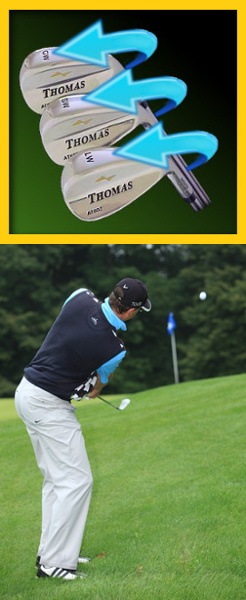
Cover Up a Variety of Yardages
Moving on from putting, we now take a look at the wedge game. Specifically, we are going to talk about how controlling your distances is key to scoring in the red zone. Once you get inside of 100 yards, you need to be able to dial up the right yardage within a few yards either way in order to place the ball near the target. When you are farther back, you largely control your distances with club selection. That doesn't work from inside of 100 yards, however, as you will usually be using the same club for all shots.
For example, a shot hit from 75 yards will probably be handled with the same club as a shot hit from 85 or 90 yards. However, there is a big difference in that 10-15 yards, as that means as much as 45 feet when it comes time to putt. Having the ability to dial up the right number on command is one of the most important skills you can develop in your game. Professional golfers excel at this skill, but the typical amateur struggles badly when trying to adjust to partial yardages.
To help you get your game on track in this category, we have listed some tips below.
- Establish full swing yardages first. The initial step in this process is going to be determining exactly how far you can hit each of your wedges with a full swing. Unfortunately, you can't get this info on the range, because range balls simply don't perform the same as actual golf balls. Record your wedge distances while on the course over the period of a few rounds until you can settle on some solid numbers. Of course, you should ignore any shots which are hit under extreme circumstances, such as when you are playing way up or down a hill. By figuring out exactly how far you can hit the ball with each short club, you will then be able to make adjustments more reliably.
- Have three distances with each wedge. Most amateur golfers carry three wedges in their golf bag – a pitching wedge, a sand wedge, and a lob wedge. If you learn how to hit three different shots with each of those three clubs, you will suddenly be able to cover nine different numbers with your wedges. With each wedge, you should be able to hit a full shot, a half shot, and a three-quarter shot. As long as you can execute those shots consistently, it will be rather easy to hit a shot that is relatively close to the right number for each situation you face.
- Alter the length of the club. Choking down on the grip of the club is one of the best things you can do to adjust your distances. Come down an inch or two from the end of the grip to take a bit of distance off of the shot – and come down even farther to create a much shorter, lower flight. It is hard to reliably adjust the length of your swing to produce the right distance, but it is easy to choke down the same amount over and over again. Also, you can move the ball a little farther back in your stance than normal when you want to reduce distance and lower trajectory.
We have to be honest here – it is going to take some time to learn this skill. It is not easy to alter your distances reliably in the wedge game, so you shouldn't expect to master this after just a trip or two to the practice range. You can get there, of course, but only after putting in plenty of work on your technique.
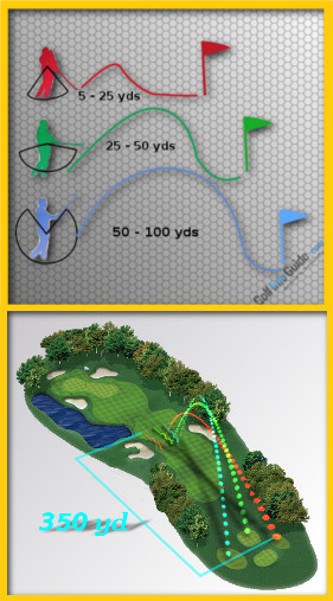
The Strategy Element
So far, we have talked about being able to hit quality shots with your putter and your wedges. Those are vital skills, to be sure, but they aren't going to get you far without reliable strategy. You need to think clearly at all times on the golf course, but especially when you are within 100 yards of the hole. It is easy to make mistakes in this range, and those mistakes are usually made out of laziness. Most golfers just 'point and shoot' from inside 100 yards, assuming that they don't need to think strategically. The mistakes that come from failing to think critically on these shots will cost you in a big way.
The list below contains some of the key strategies to keep in mind when inside the red zone.
- Stay below the hole. You could call this the 'golden rule' of red zone play. Whenever possible, you want to do what you can to keep the ball underneath the hole – in other words, you want to leave yourself with uphill shots. It is significantly easier to play uphill as compared to downhill, as the ball will stop quicker when going up a slope. This is true both when putting and when hitting wedge shots. As you plan out your approach shot into the green, for instance, you should be thinking about how you can get close to the target while still leaving the ball on the low side. Golf isn't always about hitting great shots. Sometimes, it is simply about placing the ball in the right spot to give yourself an easy par. Look for the low side from the first hole to the last and you will be amazed at how quickly your scores can improve.
- Avoid the short side. This second point is nearly as important as the first. Just as you want to keep your ball below the hole whenever possible, you also want to keep the ball on the wide side of the green. In other words, if the hole is cut on the right side of the putting surface, you want to leave your approach shot on the left. Hopefully, you will hit the green and have a birdie putt, but even if you miss, playing to the wide side will give you an easier chip. It is hard to get up-and-down when you leave your ball on the short side, especially if the short side is also the high side. You will inevitably miss on the short side from time to time with long approach shots, but there is no reason to make such a mistake when already in the red zone. With a wedge in your hands, pick out a target that is on the wide side of the hole and execute your swing to hit your target as accurately as possible.
- Prioritize a safe result. It is easy to become too aggressive when you get inside the red zone. For instance, if you are facing an approach shot to a hole located near a pond or deep bunker, you might fire right at it just because you only have 75-yards to the target. However, it is still possible to make a mistake on such a shot. You could miss-hit the ball slightly, or you could misjudge the wind – and suddenly you would be faced with a difficult recovery shot, or even a penalty stroke. If you are going to finish the day with a good score, you simply can't afford to waste strokes when you have red zone opportunities. It would be great to make a birdie, but it would be a major error to card a bogey or worse. Do your best to pick targets and plan shots which give you a great chance at par while still keeping open the possibility of a birdie.
- Be aggressive when the time is right. It is up to you to balance the last two points on this list. Yes, you want to be smart about keeping your ball in a safe position, but you also want to go for it when the course gives you a chance. On those red zone shots where there doesn't appear to be any trouble in sight, take dead aim at the target and make a great swing. The same goes for putting. On some putts, such as long, downhill efforts, you will need to guard against being too aggressive. However, you will find some opportunities when you have a relatively short uphill putt where you can use confident speed to knock the ball into the back of the cup.
Strategy is always important in golf, no matter where on the course you happen to be standing. You always have a variety of options at your disposal for each shot, so consider them all and come to a conclusion only when you are sure that you have selected the right path. It isn't always the most talented golfer who comes out on top at the end of the day – sometimes, it is simply the golfer with the best plan.
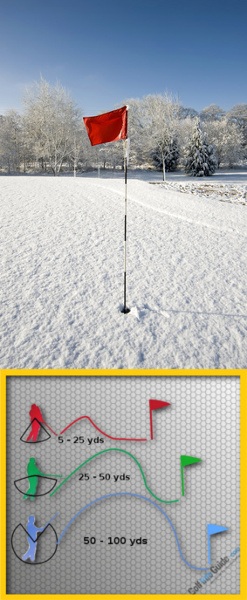
Know the Course Conditions
Understanding the condition of the course is important for all of your shots, but again here, this is another point that takes on extra meaning as you get closer to the green. You need to know how the ball is going to react when it lands, and you need to know how the ground is going to feel under the ball when making your swing. So which course conditions are important with regard to the red zone? Check out the following list.
- Green speeds. You will obviously need to have an understanding of the green speeds when putting, but this information also comes in handy when you are trying to chip or pitch the ball the correct distance. Hit plenty of warm up putts before the round starts to develop a feel for the greens that will help you once the round begins.
- Firmness of the turf. The experience of playing golf on a dry course is dramatically different from playing on a wet one. Feel the ground beneath your feet as you walk for an idea of the turf conditions, and also watch to see how easily the turf comes out of the ground when you take a divot.
- Length of the rough. It is important to know the length and thickness of the rough because this will affect your strategic decision making. When playing a course with difficult rough, it makes sense to play it safe and do your best to keep the ball on the short grass. However, when the rough isn't much different than the fairway, you can be aggressive and not worry if you stray a bit off the short grass.
If you want to take your scores to a new level, you are going to need to play well inside the red zone. That is easier said than done, however, so be sure to use the advice offered in this article to keep you on track. Good luck!






